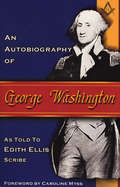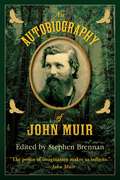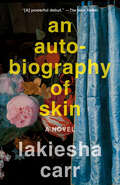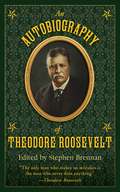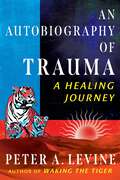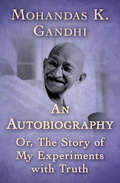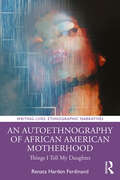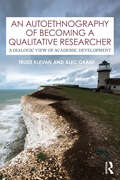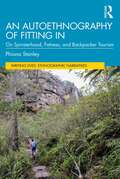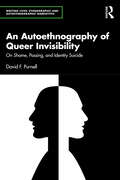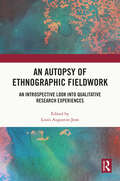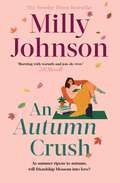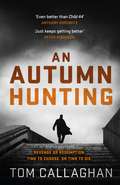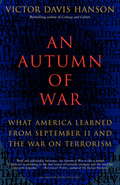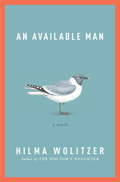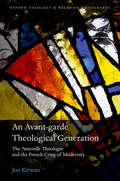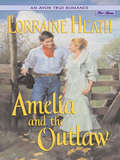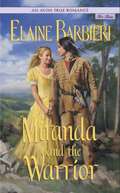- Table View
- List View
An Autobiography of George Washington
by Edith EllisScribe Edith Ellis met the spirit of George Washington one evening in 1955. He contacted her from the Other Side to ask if she would serve as a channel so that he could dictate his autobiography for his "fellow American Patriots," believing that he had kept his personal feelings about his life far too private. Edith agreed, although she was nearly blind and in her mid-70s. So began a most extraordinary partnership between Edith Ellis and the "Founding Father of America." The result is this remarkable book that has taken more than 60 years to reach the public. This book is a must-read for everyone who feels the spirit of the Founding Fathers surrounding us again.
An Autobiography of John Muir
by Stephen BrennanBiographer Steven J. Holmes once wrote that John Muir was "one of the patron saints of twentieth-century American environmental activity." In his lifetime, the engineer, author, biologist, and activist worked alongside powerful men such as President Theodore Roosevelt, railroad executive E. H. Harriman, and conservationist Gifford Pinchot. Muir was responsible for the creation of the Sierra Club and he played an important role in preserving the Yosemite Valley and Sequoia National Park.During his lifetime, Muir published six different volumes of nature and personal writing. After his death in 1914, four more volumes were discovered and released. In An Autobiography of John Muir, editor Stephen Brennan brings to light the many accomplishments of Muir's life through the naturalist's own nonfiction works, including The Story of My Boyhood and Youth and My First Summer in the Sierra.Through the essays featured in this book, readers will learn of Muir's childhood, which was split between Scotland and a farm in Wisconsin. They will travel the world with him, from the High Mountains to the Mono Trail, the Bloody Canyon, Yosemite, and everywhere in between.
An Autobiography of Joseph Conrad
by Stephen BrennanHeart of Darkness author Joseph Conrad (born Józef Teodor Konrad Korzeniowski in 1857) was a Polish writer who learned to read, write, and speak English after he was granted British nationality in 1886. Although his peers accepted him as a British gentleman, he never forgot where he came from. In fact, the history of his native land of Poland often inspired the short stories and novels he penned. Those details, along with the experience he'd had since moving to Great Britain, found their way into many of his published works.In An Autobiography of Joseph Conrad, editor Stephen Brennan has selected pieces from some of Conrad's better known nonfiction works-including The Mirror of the Sea (1906) and A Personal Record (1912)-to showcase some of the more exciting and trying times in the novelist's life. Readers will attend school with Conrad in Russian Poland, sail with him in Marseille, and meet family members who took part in his upbringing, such as Uncle Tadeusz.Portraits of Conrad throughout the years, in addition to photos of his town, home, and family, supplement the text and help readers envision the author and his surroundings during various stages in his life.
An Autobiography of Skin: A Novel
by Lakiesha CarrA NEW YORKER BEST BOOK OF THE YEAR • This magisterial, intimate look at Black womanhood "follows three women whose various traumas haunt them literally and metaphorically, as it explores what it means to be a Black woman in America today" (The New York Times Book Review, Editor's Choice).A middle-aged woman feed slots at a secret back-room parlor. A new mother descends into a devastating postpartum depression, wracked with the fear that she is unable to protect her children. A daughter returns home to join the other women in her family waging spiritual combat with the ghosts of their past. An Autobiography of Skin is a dazzling and masterful portrait of interconnected generations in the South from a singular new voice, offering a raw and tender view into the interior lives of Black women. It is at once a powerful look at how experiences are carried inside the body, inside the flesh and skin, and a joyous testament to how healing can be found within—in love, mercy, gratitude, and freedom.
An Autobiography of Theodore Roosevelt
by Stephen BrennanBased in part on his own writings, this is the true story about one of America's most beloved leaders. From president of the board of New York City Police Commissioners, secretary of the Navy, founder of the Rough Riders during the war with Cuba, his time as the governor of New York, to vice president and eventually, after the assignation of President McKinley, becoming the twenty-sixth president of the United States, Theodore Roosevelt's role in the shaping of the United States is still felt today. Illustrated with drawing and photos, discover the rich history of this great man's life here.
An Autobiography of Trauma: A Healing Journey
by Peter A. Levine• Shares the author&’s personal journey to heal his severe childhood trauma as well as his breakthroughs on the path to create Somatic Experiencing• Explores how he came to view Einstein as his personal spirit guide and mentor, only to discover a profound real-life connection to him through his mother• Explains how the SE method is derived from the author&’s studies of animals in their natural environments, neurobiology, and 50 years of clinical observationsIn this intimate memoir, renowned developer of Somatic Experiencing, Peter A. Levine—the man who changed the way psychologists, doctors, and healers understand and treat the wounds of trauma and abuse—shares his personal journey to heal his own severe childhood trauma and offers profound insights into the evolution of his innovative healing method.Casting himself as a modern-day Chiron, the wounded healer of Greek mythology, Levine describes, in graphic detail, the violence of his childhood juxtaposed with specific happy memories and how being guided through Somatic Experiencing (SE) allowed him to illuminate and untangle his traumatic wounds. He also shares the mysterious and unexpected dreams and visions that have guided him through his life&’s work, including his dreamlike visitations from Albert Einstein, whom he views as his personal spirit guide and mentor.Explaining how he helped thousands of others before resolving his own trauma, he details how the SE method is derived from his studies of wild animals in their natural environments, neurobiology, and more than 50 years of clinical observations. Levine teaches us that anyone suffering from trauma has a valuable story to tell, and that by telling our stories, we can catalyze the return of hope, dignity, and wholeness.
An Autobiography or The Story of My Experiments with Truth
by M. K. GandhiGandhiji's autobiography, "The Story of My Experiments with Truth" is one of the most read titles of the world. The autobiography has been translated in more than 15 languages in India and is available in more than 50 different languages world wide. Navajivan Trust had published the title under Gandhiji's supervision first in 1927 and has sold more than 19,00,000 copies so far. The book has inspired more and more people to study Gandhiji's thoughts and deeds.
An Autobiography or The Story of My Experiments with Truth: A Table of Concordance
by Tridip SuhrudIn his translator's preface to the revised edition of Gandhiji's autobiography, Mahadev Desai stated:It has now undergone careful revision, and from the point of view of language, it has had the benefit of careful revision by a revered friend, who, among many other things, has the reputation of being an eminent English scholar. The identity of the 'revered friend' was not disclosed, nor were the extent and nature of changes recorded. This concordance table reconstructs the entire process of revision and provides a detailed analysis of the changes made by Sir V S Srinvasas Sastri.
An Autobiography or the Story of My Experiments with Truth
by Mahatma GandhiAlthough Gandhi presents his episodes chronologically, he leaves wide gaps, such as the entire satyagraha struggle in South Africa, for which he refers the reader to another of his books.
An Autobiography: Or, The Story of My Experiments with Truth (Mobi Classics Ser.)
by Mohandas K. GandhiThe remarkable life and inspiring beliefs of a legendary peacemaker and liberator of India—in his own words. Remember that all through history, there have been tyrants and murderers, and for a time, they seem invincible. But in the end, they always fall. Always. In the story of his life from early childhood through 1921, Mohandas K. Gandhi candidly reveals his young investigations into sin and seeking atonement; the philosophy, art, and literature that influenced his thoughts and ideas; and his first experiences with politics and protest, which would provide the foundation for his nonviolent struggle for justice, equality, and Indian independence from the British Empire. Gandhi&’s intention in setting down an account of his formative years was to clarify the spiritual principles by which he lived and to inspire individuals and movements in their quests for personal and political freedom. The timeless lessons to be derived from the autobiography of this dedicated seeker of truth and brilliant leader continue to resonate wherever freedom is challenged by tyranny. This ebook has been professionally proofread to ensure accuracy and readability on all devices.
An Autoethnography of African American Motherhood: Things I Tell My Daughter (Writing Lives: Ethnographic Narratives)
by Renata Harden FerdinandThis is the first full-length explicitly identified autoethnographic text on African American motherhood. It shows the lived experiences of Black motherhood, when mothering is shaped by race, gender, and class, and mothers must navigate not only their own, but also their children's positions in society. Ferdinand takes an intimate look at her mothering strategies spanning ten years (from 2007 to 2017), preparing her daughter to traverse a racist and sexist society. It is a multi-generational text that blends the author’s experience with that of her own mother, grandmother, and her daughter, to engage in a larger discussion of African American/Black mother/womanhood. It is grounded within Black Feminist Theory, which centers the experiences of Black women within the domains of intersecting oppressions. It is from a very personal position that Ferdinand provides a glimpse into the minutiae of mothering that reveal the everyday intricacies of Black women as mothers. It highlights specific strategies Black mothers use to combat discrimination and oppression, from teaching their children about the n-word to choosing positive representations of Black identity in movies, books, dolls, daycares, elementary schools, and even extra-curricular activities. It shows the impact that stereotypical manifestations of Black femininity have on Black women’s experience of motherhood, and how this affects Black women and girls' understanding of themselves, especially their skin color, body shape, and hair texture. As an interdisciplinary text, this book will be reading for academics and students in a broad range of fields, including Education, African American Studies, Communication Studies, Women Studies, Psychology and Health Studies. It is also a handbook of lived experience for Black mothers, grandmothers, and daughters, and for all mothers, grandmothers, and daughters irrespective of color.
An Autoethnography of Becoming A Qualitative Researcher: A Dialogic View of Academic Development
by Alec Grant Trude KlevanAn Autoethnography of Becoming a Qualitative Researcher chronicles Trude Klevan's personal experiences of her doctoral journey, with Alec Grant as an external academic resource and friend, and her subsequent entry into the neoliberal higher education environment. It gives a personal and intimate view of what it's like to become an academic. This book is constructed as an extended dialogue which frequently utilizes email exchanges as data. Firmly grounded in the epistemic resource of friendship, it tells the story of the authors’ symbiotic academic growth around their critical understanding and knowledge of qualitative inquiry and the purposes of such knowledge. The tale told is of the unfolding of a close and mutually beneficial relationship, entangled within sometimes facilitative, sometimes problematic, environmental contexts. It uses these experiences to describe, explore, and critically interrogate some underlying themes of the philosophies, politics, and practices of qualitative inquiry, and of higher education. Disrupting conventional academic norms through their work, friendship, and correspondence, Trude and Alec offer a critical and epistemological view of what it's like to become a qualitative researcher, and how we can do things differently in higher education. This book is suitable for all researchers and students, their supervisors, mentors, and teachers, and academics of qualitative research and autoethnography, and those interested in critiques of higher education.
An Autoethnography of Fitting In: On Spinsterhood, Fatness, and Backpacker Tourism (Writing Lives: Ethnographic Narratives)
by Phiona StanleyAn Autoethnography of Fitting In: On Spinsterhood, Fatness, and Backpacker Tourism is a feminist narrative about the social rules of obedience and acquiescence to the norm – embodiment, heteronormativity, partnering – and about fitting in, or not, with those narratives. Phiona Stanley explores a period through her twenties and thirties, living and travelling alone, foreign to herself and the countries of her travel in all regards: white, cisgender, sometimes thin, sometimes fat, sometimes partnered. This fascinating volume uses these lived experiences, depicted through first-person narrative storytelling, as a prism through which to understand the subtle, social rules of gendered normative expectations. It draws on contemporary journals, letters, and photos, and features process-oriented sections that focus on the methodological possibilities these offer, and on questions of verisimilitude and subjectivity. Set in the context of transnational work in Qatar, China, and elsewhere, and "road status" as negotiated and performed among long-term backpacker tourists, this book serves as an exemplar of how autoethnography can illuminate socio-cultural normativities and their effects – which are rarely explicit, but which nevertheless have great potential to harm – while problematizing and rethinking the meanings and semantic boundaries of weight, queerness, and (hetero)normativity. Framed through reflexive autoethnography, with a strong focus on ethics and feminist theories, this book will appeal to students and researchers in autoethnography, qualitative methods, and gender and women's studies.
An Autoethnography of Letter Writing and Relationships Through Time: Finding our Perfect Moon (Writing Lives: Ethnographic and Autoethnographic Narratives)
by Jennifer L. AdamsAn Autoethnography of Letter Writing and Relationships Through Time: Finding Our Perfect Moon is about love letters, stories, and the ability of words to bring people together across time and physical space. Weaving together edited and annotated letters between a young couple in the 1930s with interludes of autoethnographic reflection, the book relates the author’s experiences as she has negotiated this project over 20 years. Reading the letters is a sepia-toned window into the very private world of two young, well-educated Jewish-American people who lived their lives against the backdrop of the Jazz Age, the Great Depression, and Prohibition. The author uses reflective autoethnographic interludes to tell the story of finding the letters and to explore the significance of letters as a communicative genre. Adams considers the ethical implications of being a researcher eavesdropping on private moments in others' lives, and she explores the function of dialogue in the development of the romantic relationship that unfolds in the letters and between the letters and her. The author also advocates for the everyday relational communication practices that collectively comprise life's most important experiences. Students and researchers interested in letter-writing, autoethnography, and relationship development will find relevance in this book. It will also be of value to those interested in letter collections, the ethical implications of intimate research on people from the past who cannot offer consent, the role of nostalgia in interpersonal communication, and anyone who thrills at a love story told from primary documents from the past.
An Autoethnography of Queer Invisibility: On Shame, Passing, and Identity Suicide (Writing Lives: Ethnographic Narratives)
by David PurnellThis book recounts a personal journey of self-acceptance, focusing on the author's creation and reliance of a persona (Paul D. Drevlin) as a defense mechanism against societal and familial pressures.Beginning with a childhood marked by traumatic events, the author begins his desire of invisibility, later adopting the persona of Drevlin to navigate societal expectations and challenges, including his struggles with identity, sexuality, and religious conservatism. This book explores how the persona initially provided protection, safety, and acceptance to eventual self-realization that the persona was more a prisoner than a protector.The aim of this book is to open discussion regarding the shifts in acceptance experienced by the LGBTQ+ community over the years. It underscores the importance of family (whether that be birth family or family of choice) and peer support, community acceptance, and the changing dynamics of LGBTQ+ landscapes. The book also aims to stress the significance of fostering an inclusive society and respecting the diverse identities of individuals, advocating for understanding, empathy, and collective efforts toward equality and acceptance.Suitable for students studying LGBTQ+ studies, gender studies, sociology, psychology, social work, and creative writing, this book will also appeal to non-academic readers who may find the cultural and family themes significant to their own lives.
An Autopsy of Ethnographic Fieldwork: An Introspective Look into Qualitative Research Experiences
by Louis Augustin-JeanThis edited volume presents an international collection of fieldwork experiences from every stage of the research process with a view to normalising the process of adaptation, modification, and even failure during fieldwork when circumstances interrupt the expected outcomes.This book aims to address a gap often found in methodology books by including nine full autopsy-like reflection of fieldwork experiences, selected based on researchers’ disciplines and fields, the diversity of geographical locations and their differing themes. Its chapters record a swath of experience, from choosing the research themes and hypotheses through to academic presentations and publications, shedding light on an area academic research that is often overlooked.Documenting experience from anthropologists and sociologists to political scientists and economists, the diversity of the book’s approach and its multidisciplinary focus will interest researchers, scholars, and postgraduate students from a range of subdisciplines and levels of fieldwork experience.
An Autumn Crush: A Spring Affair, A Summer Fling, An Autumn Crush, A Winter Flame (THE FOUR SEASONS)
by Milly JohnsonFrom the Sunday Times bestselling author&‘The feeling you get when you read a Milly Johnson book should be bottled and made available on the NHS&’ Debbie JohnsonFour friends, two crushes and a secret ... After a bruising divorce, headstrong Juliet Miller invests in a flat and advertises for a flatmate, little believing that in her late thirties she'll find anyone suitable. But along comes self-employed copywriter Floz, raw from her own relationship split, and the two woman hit it off. When Juliet's twin brother Guy meets Floz, he is overcome with a massive crush, just as his friend Steve develops the hots for Juliet. But being a shy, gentle giant, Guy communicates so clumsily with Floz as to give her the opposite impression. Can he turn Floz's affection for his family into love for him? And then Juliet makes a discovery, which will turn their lives upside-down ...Praise for Milly Johnson: 'Every time you discover a new Milly book, it&’s like finding a pot of gold' heat 'A glorious, heartfelt novel' Rowan Coleman &‘Absolutely loved it. Milly's writing is like getting a big hug with just the right amount of bite underneath. I was rooting for Bonnie from the start' Jane Fallon &‘Bursting with warmth and joie de vivre&’ Jill Mansell &‘Warm, optimistic and romantic&’ Katie Fforde
An Autumn Hunting
by Tom Callaghan'Even better than Child 44. Akyl Borubaev is a terrific creation' Anthony Horowitz'Just keeps getting better . . . buy the whole series right away' Peter Robinson, No.1 bestselling author of Sleeping in the GroundNo sooner has Akyl Borubaev been reinstated as an Inspector in the Bishkek Murder Squad than he's suspended for alleged serious crimes against the state. After an attempted assassination of a prominent minister goes spectacularly wrong, Akyl is a fugitive from his former colleagues and involved with one of Kyrgyzstan's most dangerous criminals. On the run, caught up in a illegal scheme that can only end badly, it's time for Akyl to take a stand for everything he believes in.
An Autumn War (Long Price Quartet, Book Three)
by Daniel AbrahamDaniel Abraham delighted fantasy readers with his brilliantly original and engaging first novel, and in his second penned a tragedy as darkly personal and violent as Shakespeare's King Lear. Now he has written an epic fantasy of much wider scope and appeal that will thrill his fans and enthrall legions of new readers. Otah Machi, ruler of the city of Machi, has tried for years to prepare his people for a future in which the magical andat, entities that support their commerce and intimidate all foes, can no longer be safely harnessed. But his efforts are too little, too late. The Galts, an expansionist empire from across the sea, have tired of games of political espionage and low-stakes sabotage. Their general, a ruthless veteran, has found a way to do what was thought impossible: neutralize the andat. As the Galtic army advances, the Poets who the andat wage their own battle to save their loved-ones and their nation. Failure seems inevitable, but success would end the Galtic threat. With wonderful storytelling skill, Abraham has wedded the unique magic, high-stakes betrayal and political intrigue of his previous works with a broad tapestry of action in a spectacular fantasy epic.
An Autumn of War: What America Learned from September 11 and the War on Terrorism
by Victor Davis HansonOn September 11, 2001, hours after the terrorist attacks on New York and Washington, the eminent military historian Victor Davis Hanson wrote an article in which he asserted that the United States, like it or not, was now at war and had the moral right to respond with force. An Autumn of War, which opens with that first essay, will stimulate readers across the political spectrum to think more deeply about the attacks, the war, and their lessons for all of us.
An Available Man
by Hilma WolitzerIn this tender and funny novel, award-winning author Hilma Wolitzer mines the unpredictable fallout of suddenly becoming single later in life, and the chaos and joys of falling in love the second time around. When Edward Schuyler, a modest and bookish sixty-two-year-old science teacher, is widowed, he finds himself ambushed by female attention. There are plenty of unattached women around, but a healthy, handsome, available man is a rare and desirable creature. Edward receives phone calls from widows seeking love, or at least lunch, while well-meaning friends try to set him up at dinner parties. Even an attractive married neighbor offers herself to him.The problem is that Edward doesn't feel available. He's still mourning his beloved wife, Bee, and prefers solitude and the familiar routine of work, gardening, and bird-watching. But then his stepchildren surprise him by placing a personal ad in The New York Review of Books on his behalf. Soon the letters flood in, and Edward is torn between his loyalty to Bee's memory and his growing longing for connection. Gradually, reluctantly, he begins dating ("dating after death," as one correspondent puts it), and his encounters are variously startling, comical, and sad. Just when Edward thinks he has the game figured out, a chance meeting proves that love always arrives when it's least expected.With wit, warmth, and a keen understanding of the heart, An Available Man explores aspects of loneliness and togetherness, and the difference in the options open to men and women of a certain age. Most of all, the novel celebrates the endurance of love, and its thrilling capacity to bloom anew.BONUS: This edition contains questions and topics for discussion.
An Avant-garde Theological Generation
by Jon KirwanAn Avant-garde Theological Generation examines the Fourvière Jesuits and Le Saulchoir Dominicans, theologians and philosophers who comprised the influential reform movement the nouvelle théologie. Led by Henri de Lubac, Jean Daniélou, Yves Congar, and Marie-Dominique Chenu, the movement flourished from the 1930s until its suppression in 1950. It aims to remedy certain historical deficiencies by constructing a history both sensitive to the wider intellectual, political, economic, and cultural milieu of the French interwar crisis, and that establishes continuity with the Modernist crisis and the First World War. Chapter One examines the modern French avant-garde generations that have shaped intellectual and political thought in France, providing context for a historical narrative of the nouvelle théologie. Chapters Two and Three examine the influential older generations that flourished from 1893 to 1914, such as the Dreyfus generation, the generation of Catholic Modernists, and two generations of older Jesuits and Dominicans, which were instrumental in the Fourvière Jesuits' development. Chapter Four explores the influence of the First World War and the years of the 1920s, during which the Jesuits and Dominicans were in religious and intellectual formation, relying heavily on unpublished letters and documents from the Jesuits archives in Paris (Vanves). Chapter Five analyses the crises of the interwar period and the emergence of the wider generation of 1930--to which the nouveaux théologiens belonged--and its intellectual thirst for revolution. Chapter Six examines the emergence of the ^ ressourcement thinkers during the tumultuous years of the 1930s. The decade of the 1940s, explored in Chapter Seven, saw the rise to prominence of the members of the generation of 1930, who, thanks to their participation in the resistance, emerged from the Second World War, with significant influence on the postwar French intellectual milieu. Finally, the monograph concludes in Chapter Eight with an examination of the triumph of French Left Catholicism and the nouvelle théologie during the 1960s at the Second Vatican Council.
An Avocado a Day: More than 70 Recipes for Enjoying Nature's Most Delicious Superfood
by Lara FerroniGo beyond guacamole! Research shows that adding an avocado a day to your diet helps improve your overall health, and this cookbook will show you how to enjoy avocados in 70 delicious and different ways. Even most avocado lovers don't know what to do with them beyond adding a slice or two to a sandwich or mashing one into guacamole. Here are 70 simple and delicious tasty recipes for everything from breakfast to dessert, including Avocado Green Curry Noodles, Tequila, Citrus and Ginger Stuffed Avocados, Avocado Waffles, and Avocado Key Lime Pie. Lara Ferroni educates readers on the various kinds of avocados and how to pick them, store them, and even grow them! Home cooks will learn how to make use avocado butter, oil, and honey, and how to incorporate avocados into any every meal of the day.From the Hardcover edition.
An Avon True Romance: Amelia and the Outlaw
by Lorraine HeathAmeliaWith a strict, eagle-eyed judge for a father and two older brothers to back him up, Amelia Harper is doted upon and protected within an inch of her life. She's not even allowed to have a sweetheart until she's seventeen, for example. Amelia longs for the day she can do as she pleases, but that day doesn't seem to be in any hurry to arrive.The OutlawFor a young fellow, Jesse Lawton has a surprisingly shady background. The only wonder is that it took him until the age of fourteen to end up in jail, so wild was the path he'd been on. But five years have passed, and his luck finally seems to have turned: he's been freed. If only he can stay on the straight and narrow . . .When Jesse arrives at the Harper ranch to work off the remainder of his sentence, it's no surprise that the judge's pretty daughter catches his eye. What he doesn't know is that this young lady is itching for excitement, and with one look into his haunted eyes, Amelia knows she's found it in Jesse. Without meaning to, Amelia forces the erstwhile outlaw into a choice between his freedom and his heart.
An Avon True Romance: Miranda and the Warrior
by Elaine BarbieriJust as the Avon name means adult romance, so the name Avon True Romance will mean captivating love stories for the younger set. Written with teen readers in mind, our books will tap into the young adult market while maintaining the high level of passionate writing that the adult Avon romances possess. It's 1852. Defiant 17-year-old Miranda leaves her South Dakota fort in spite of her father's warnings of the presence of Cheyenne war tribes. Before she knows what has happened, she's nabbed by a celebrated warrior who is just as stubborn as Miranda.
